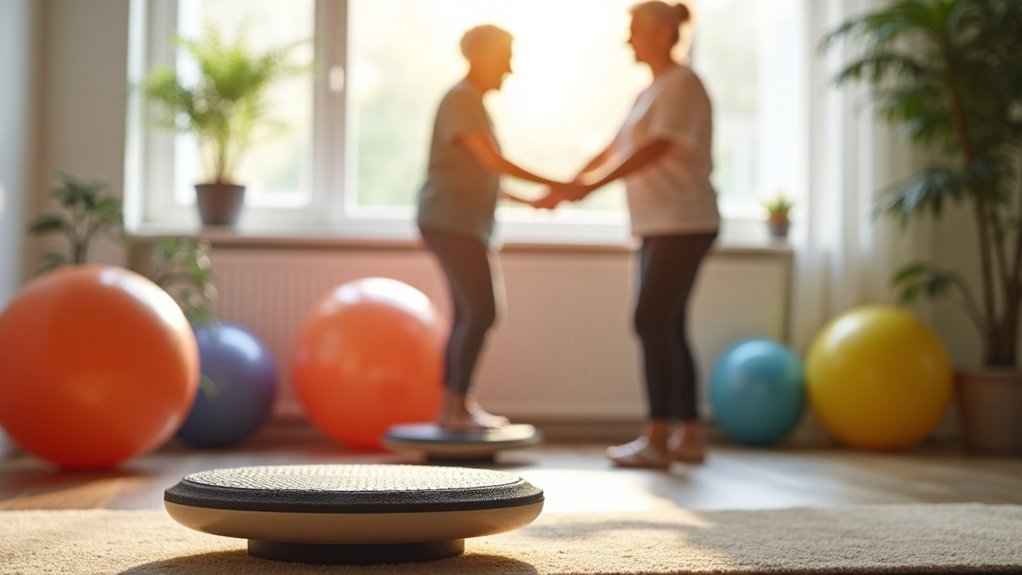Three essential balance therapy tools for dementia patients include balance trainers, stability balls/cushions, and handheld balance poles. Balance trainers provide adjustable support for personalized rehabilitation, while stability balls and cushions activate core muscles through gentle, unstable surfaces. Handheld balance poles offer direct stability assistance with easy-grip surfaces for those with dexterity challenges. These tools not only reduce fall risks but also integrate cognitive components that support both physical and mental well-being throughout progression.
Balance Trainers: Supporting Safe Movement for Cognitive Decline

As cognitive abilities decline in dementia patients, their physical stability often deteriorates in tandem. Balance trainers like the ADL Balance Trainer offer essential support, helping improve balance and reduce fall risks while patients stand, shift, and reach.
Your physical therapist can create personalized rehabilitation programs using these trainers’ adjustable platforms, tailoring challenges to individual needs. These tools don’t just build stability and strength in core muscles—they incorporate cognitive components through interactive activities that stimulate mental function alongside physical movement.
What makes balance trainers particularly valuable is how they foster independence and confidence. As you support safe movement for loved ones experiencing cognitive decline, you’re not just preventing falls—you’re helping maintain their quality of life through engaging therapy that addresses both physical and mental challenges.
Stability Balls and Cushions: Gentle Foundations for Dementia Care
When caring for dementia patients, stability balls and cushions offer more than just physical support—they provide gentle yet effective foundations for essential balance work.
These versatile tools create unstable surfaces that naturally activate core muscles, helping improve stability and reduce fall risk during daily activities.
You’ll find that foam balance cushions accommodate mobility challenges while enabling a variety of therapeutic exercises.
Stability balls enhance balance through low-impact movements that are both accessible and engaging for patients with cognitive decline.
The playful nature of these tools stimulates cognitive function while supporting physical therapy goals.
You can easily integrate them into personalized therapy plans, giving you flexible options to enhance mobility while ensuring patient safety.
This dual cognitive-physical approach makes stability balls and cushions invaluable assets in thorough dementia care.
Handheld Balance Poles: Confidence Builders for Memory-Impaired Users

Handheld balance poles represent the next step in supporting mobility for dementia patients who need more direct stability assistance. They’re lightweight and feature easy-grip surfaces that accommodate users with dexterity challenges while promoting proper posture and reducing the risk of falls.
| Benefit | Application |
|---|---|
| Stability | Provides reliable support during walking exercises |
| Confidence | Encourages users to attempt more mobility activities |
| Cognitive | Engages mind through directional movement patterns |
| Independence | Adjustable height adapts to individual physical abilities |
You’ll find these versatile tools particularly valuable in group settings where dementia patients can practice synchronized movements. The poles’ adjustable features accommodate varying physical abilities, while the structure of pole exercises enhances both cognitive function and social engagement—making them perfect confidence builders for memory-impaired individuals seeking independence in movement.
Frequently Asked Questions
How Can Dementia Patients Improve Balance?
You can improve balance through structured exercises like single-leg stands, strength training with professional guidance, and using visual cues. Regular practice helps reduce fall risk and maintains your independence despite dementia.
What Equipment Is Used for Balance Exercises?
You’ll need stability balls, balance boards, resistance bands, wobble discs, foam rollers, and balance beams for effective exercises. These tools strengthen your core muscles, improve coordination, and enhance stability during balance training.
What Is Best for Dementia Patients?
For dementia patients, you’ll find stability balls with visual cues, balance boards with railings, and wobble cushions most effective. They’re simple to use, enhance cognitive-physical connections, and provide necessary safety during exercises.
What Are the Reminder Tools for Dementia Patients?
You’ll find visual cues like calendars, technology-based alerts, labeled containers, memory aids with photos, and routine checklists are all effective reminder tools. These help you maintain independence and structure in daily activities.
In Summary
Balance therapy isn’t just physical—it’s emotional support for those with dementia. You’ll find these three tools invaluable in your caregiving journey. Balance trainers, stability equipment, and handheld poles work together to reduce fall risks while boosting your loved one’s confidence and independence. Remember, maintaining physical stability often helps preserve dignity and quality of life throughout cognitive decline. Start small, celebrate progress, and prioritize safety above all.





Leave a Reply